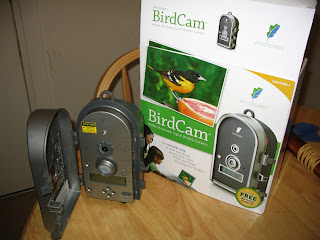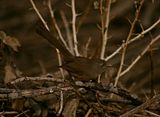Well, guess what arrived on my front step a few days ago?
 Ain't it purty? I'm pretty psyched about this thing. It's a new toy I've pondered about for a while. I was so excited I ran to get batteries for the thing and try it out. Since we haven't had much activity at our feeders for a while I decided I wanted to try it along the path where we've been spotting the mountain lion tracks. So I went out around sundown to go set it up, knowing that the sensor wouldn't turn on until sunrise, but hoping that it might catch something walking by in the early morning light. Well, the results weren't quite as exciting as I'd hoped (but not for lack of how cool this thing is).
Ain't it purty? I'm pretty psyched about this thing. It's a new toy I've pondered about for a while. I was so excited I ran to get batteries for the thing and try it out. Since we haven't had much activity at our feeders for a while I decided I wanted to try it along the path where we've been spotting the mountain lion tracks. So I went out around sundown to go set it up, knowing that the sensor wouldn't turn on until sunrise, but hoping that it might catch something walking by in the early morning light. Well, the results weren't quite as exciting as I'd hoped (but not for lack of how cool this thing is). Here is my first official birdcam picture...of my knee. I guess there wasn't much activity that morning. I need to figure out how to set the date, too. I suppose reading the manual might help, eh? Anyway, I haven't had time to play with it since then, so I'm waiting until Sunday to really start putzing with it. It's even got a setting to capture video. Now I just have to find a good place to set it up to capture some daytime critters. You can expect more from the birdcam in the days and weeks to come.
Here is my first official birdcam picture...of my knee. I guess there wasn't much activity that morning. I need to figure out how to set the date, too. I suppose reading the manual might help, eh? Anyway, I haven't had time to play with it since then, so I'm waiting until Sunday to really start putzing with it. It's even got a setting to capture video. Now I just have to find a good place to set it up to capture some daytime critters. You can expect more from the birdcam in the days and weeks to come.I'm still playing around with our camera, too. Here are some recent pictures from around the Well.
 Figuring out the intricacies of focusing while in the macro mode is a bit of a challenge. The depth of field (how big or small the in-focus area is) seems to get in my way a lot, as you can tell with this image of an immature greater earless lizard. I wanted to get its eye into focus, but since I was so close, and its head was turned slightly toward me, that meant its nose got all blurry. I need to figure out if there's a way to fix that. There probably is. I still like the picture though. Makes this tiny little lizard (it was perhaps 2.5 inches long, from nose-tip to tail-tip) look unnaturally large. At least I got the exposure sort of right.
Figuring out the intricacies of focusing while in the macro mode is a bit of a challenge. The depth of field (how big or small the in-focus area is) seems to get in my way a lot, as you can tell with this image of an immature greater earless lizard. I wanted to get its eye into focus, but since I was so close, and its head was turned slightly toward me, that meant its nose got all blurry. I need to figure out if there's a way to fix that. There probably is. I still like the picture though. Makes this tiny little lizard (it was perhaps 2.5 inches long, from nose-tip to tail-tip) look unnaturally large. At least I got the exposure sort of right.I'm going to start posting the settings I used to take each picture with the hopes that someone with more SLR experience than myself can give me pointers for taking better photographs. So, if you're not interested in all these numbers, you can skip ahead. For all of these pictures I put the camera on the Tv setting, so it's deciding the aperature for each shot (1/250, f5.6, ISO 200 with the Sigma 70-300mm).
 This little Rock Wren was sitting at the perfect spot for the setting sun to illuminate its head. I've noticed that when I zoom all the way in using this lens, my pictures seem a little soft. I don't know if this is a result of buying the cheapest 300mm lens I could find, or something I'm just not doing right when I take the picture. I'm wondering if I just need a better eye for getting the focus right. But if you click on the image, then you'll see what I mean. It's just a little on the fuzzy side. (1/160, f5.6, ISO 200 with the Sigma 70-300mm, focal length 300mm)
This little Rock Wren was sitting at the perfect spot for the setting sun to illuminate its head. I've noticed that when I zoom all the way in using this lens, my pictures seem a little soft. I don't know if this is a result of buying the cheapest 300mm lens I could find, or something I'm just not doing right when I take the picture. I'm wondering if I just need a better eye for getting the focus right. But if you click on the image, then you'll see what I mean. It's just a little on the fuzzy side. (1/160, f5.6, ISO 200 with the Sigma 70-300mm, focal length 300mm) With the departure of nearly all of our summer migrants, the winter residents have begun to appear in the neighborhood, including this female White-crowned Sparrow, one of the first of the season. See, this one is much crisper, but she's also in full sunlight, while the Rock Wren (and the American Dipper from the previous post) was in shadow. I'm thinking now that it might be a result of camera shake considering the slow shudder speed I used for the wren. (1/1000, f5.6, ISO 200 with the Sigma 70-300mm, focal length 300 mm)
With the departure of nearly all of our summer migrants, the winter residents have begun to appear in the neighborhood, including this female White-crowned Sparrow, one of the first of the season. See, this one is much crisper, but she's also in full sunlight, while the Rock Wren (and the American Dipper from the previous post) was in shadow. I'm thinking now that it might be a result of camera shake considering the slow shudder speed I used for the wren. (1/1000, f5.6, ISO 200 with the Sigma 70-300mm, focal length 300 mm) Finally, a picture of the morning light playing with a spider web. This one is my favorite of the bunch. (1/320, f5.6, ISO 200 with the Sigma 70-300mm, focal length 238mm)
Finally, a picture of the morning light playing with a spider web. This one is my favorite of the bunch. (1/320, f5.6, ISO 200 with the Sigma 70-300mm, focal length 238mm)















3 comments:
i like the web too. on the depth of field thing - to get more stuff in focus i think you try to increase the F-stop. you were using your 55-300 on that lizard, and that'll hurt the depth of field as well. wider lenses (like your 18-55) will have more depth of field. at least that's what i remember from the dvd's i sent you - or the empty cases. the dvds are sitting on the counter addressed to you ;)
I think the shallow depth of field really makes the lizard pop. Otherwise he/she might have been lost with all that might be going on there in the background.
Steve, the only downside of using the 18-55 is that I'd need to get within inches of the lizard to get it to be that close. Although, I suppose if it's a nice crisp picture it would look better zooming in with photoshop. I'll try increasing the f-stop, too, and see what that does.
Tim, I totally agree with your observation, but I still wish its whole head was in focus, instead of its neck. For some reason its blurry nose is really distracting to me. But I suppose that's more of just working on my skills of placing the focused area of the photograph properly. Thanks for posting!
Post a Comment